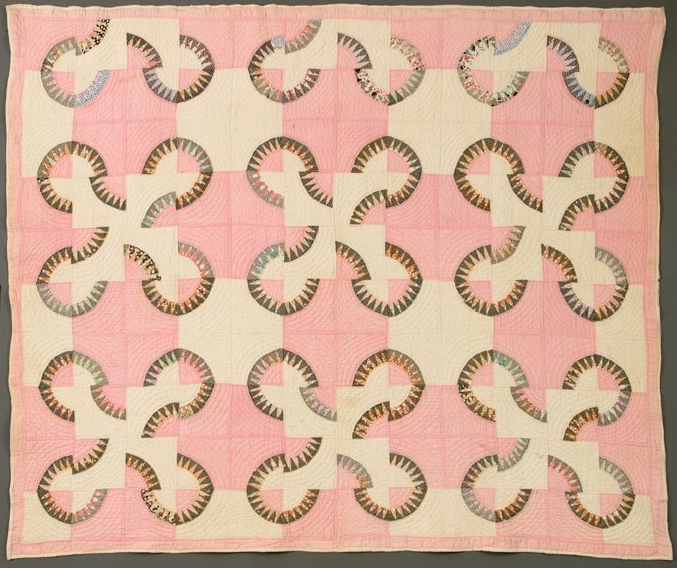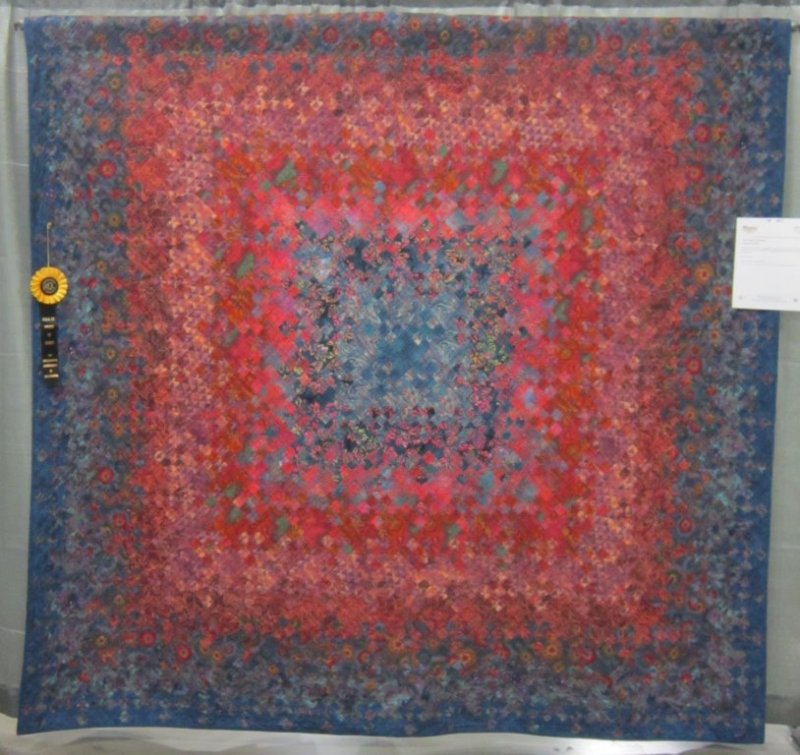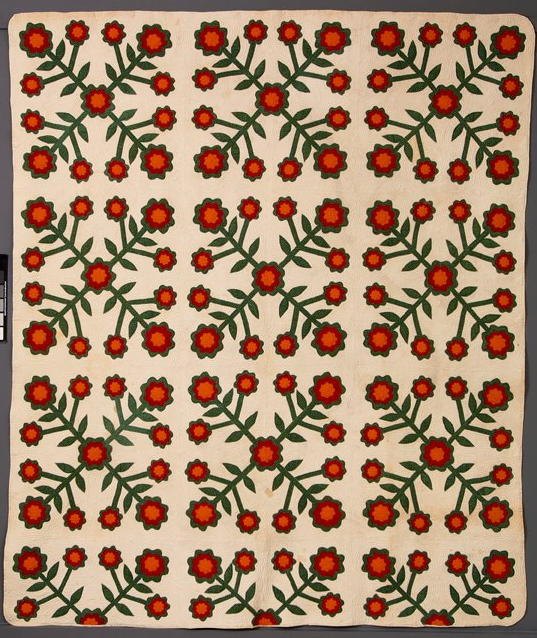Welcome to Moda Fabrics!
Quilt Appraisals—What’s It Worth?
Quilt Appraisals—What’s It Worth?
If you’ve watched Antiques Roadshow you’ve seen that thrilling moment when someone’s garage sale find is appraised at $30,000 to $50,000. But even when an item is worth no more than the $2.50 paid for it, there’s always something to learn. And so it is with quilt appraisals. 
Having a quilt appraised isn’t only about finding out it’s worth millions, and it’s not just for antique quilts, either. Quilt appraisals can be done for insurance purposes at home and to protect the value of the quilt when shipping it to or hanging it in a show. Appraisals also help determine the value of a quilt for donation or estate purposes. And finally, appraisals can provide a record of both the value and history of a quilt. It’s this last kind of appraisal that is Marcia Kalakie’s favorite.
 This a is rattlesnake quilt form Texas from the 1920s. Very humble looking quilt but the pattern is very rare and that makes it desirable.
This a is rattlesnake quilt form Texas from the 1920s. Very humble looking quilt but the pattern is very rare and that makes it desirable.
Marcia is a Texas appraiser certified 17 years ago through the American Quilter’s Society (AQS). She started seriously studying quilts at least five years before that, when she fell in love with antique quilts and realized that she needed to know more about them before buying any (her collection today is sizeable). For Marcia, it’s researching the history of quilts that’s most satisfying. “I was a mediocre history student in high school, but quilts gave me something tangible,” she says. “I knew a real, live person with talent and creativity made them. Being an appraiser and studying quilts is phenomenally pleasurable.” (That love of quilt quilt history also led her to write the book, Texas Quilts and Quilters: A Lone Star Legacy in 2007.)
When determining the value of quilt, appraisers take several things into account. For a modern quilt, the Internet can help in determining the cost of thread, fabric, and batting. Marcia prides herself on keeping up with contemporary trends and techniques so she can determine how long it takes to make a quilt. This helps her calculate the per hour cost of reproducing it. “If a quilt has 40 ruched roses on it I figure out how long it takes to make one ruched rose,” she says. This gets to the heart of an issue that not many quilters take into account when considering what their quilts are worth—the hours they put into them. “It’s important for women to see their work and time has a monetary value,” says Marcia.
 This is a Blooming Ninepatch quilt that Marcia Kaylakie made in 2014 and entered in her local (Austin, Texas) quilt guild show. It took an NQA Judges Award for quilting that year. The size of the quilt is very large and the amount of time to make blocks, amount of cost in fabric, and hand quilting all add to the value to reproduce it.
This is a Blooming Ninepatch quilt that Marcia Kaylakie made in 2014 and entered in her local (Austin, Texas) quilt guild show. It took an NQA Judges Award for quilting that year. The size of the quilt is very large and the amount of time to make blocks, amount of cost in fabric, and hand quilting all add to the value to reproduce it.
It’s especially exciting to uncover the value and history of antique quilts and Marcia may use clues such as initials, names, or dates embroidered on the quilt, as well as the stories told by those who bring them in. Provenance—the record of ownership and earliest known history—adds significant value to a quilt, but throughout the years Marcia’s learned that quilt owners and collectors may not have the story straight. “One owner was sure the quilt was made by a signer of the Declaration of Independence, but when I finished my research it turned out it was another branch of the family altogether, and the quilt was 100 years newer than they thought,” she says. She also has people bring “bundles of rags” for her to appraise. “They’re very special things to that person,” she says. “Tact is very important, because even in tatters they’re precious to that person.”
 A rose of Sharon 1860s from near Abilene, Texas. The quilt is a fine example of red/green mid-19th century with heavy echo quilting 1/3” apart
A rose of Sharon 1860s from near Abilene, Texas. The quilt is a fine example of red/green mid-19th century with heavy echo quilting 1/3” apart
This gets to an element of prime importance in quilt appraisal. “Condition, condition, condition,” says Marcia. “Only rarely—such as if it’s a quilt that owned by George Washington—would it not play very heavily.” The rarity of the pattern and what comparable quilts are currently selling for in the marketplace are also taken into account. Unlike on Antiques Roadshow, where valuation is typically done across a range (that lamp worth $30,000 to $50,000), quilt appraisers set valuation at a specific dollar amount.
Certified quilt appraisers can be found via the AQS website. Appraisals are done in person and you may have to travel to find an appraiser. Quilt shows sometimes hire them to value show quilts and guilds may hire them to lecture and do appraisals.
A certified instructor should be able to appraise quilts from any region and Marcia has enjoyed traveling the country as part of her work. She’s also seen quilts from many regions while doing appraisals in Texas. She remembers an especially exciting moment when a couple unrolled a rare Royal Hawaiian Flag Quilt in front of her. “I had to take a deep breath and walk in a small circle to gather myself, because it’s such a rare thing to see,” she says. The quilt had a clear provenance and the couple, with no children to pass it along to, wanted Marcia’s help in determining some appropriate places to donate it.
 This is a Princess Feather 1880s from around Marshall, Texas. The gray is an indicator of dye migration in the fabric and may once have been green. Note the four-block style of the quilt.
This is a Princess Feather 1880s from around Marshall, Texas. The gray is an indicator of dye migration in the fabric and may once have been green. Note the four-block style of the quilt.
The highlights of Marcia’s career aren’t always about unusual finds, however. She tells of a grandmother and her nine-year-old granddaughter who brought quilts in together. “The little girl had just made her very first quilt and wanted it appraised because her grandmother told her that’s what you do,” she says. “I still smile about that, ten years later.”
Amongst the reasons listed on Marcia's web site for appraisals is one suggesting that if you send a quilt as a gift you include an appraisal. “Some people treat their quilt better if they have an appraisal,” Marcia notes. It might be just the thing to ensure that your beautiful quilt doesn’t wind up as a cozy bed for the family dog.

Comments